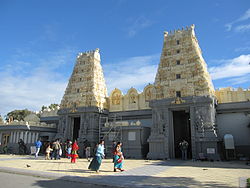 | |
 Hindu Temple in Melbourne. | |
| Total population | |
|---|---|
| Regions with significant populations | |
| Languages | |
| English, Hindi, Tamil, Telugu, Punjabi, Gujarati, Bengali, Fiji Hindi, Nepali, Mauritian Creole, Indian languages |
| Year | Pop. | ±% p.a. |
|---|---|---|
| 1911 | 414 | — |
| 1933 | 212 | −3.00% |
| 1986 | 21,500 | +9.11% |
| 1991 | 43,580 | +15.18% |
| 1996 | 67,270 | +9.07% |
| 2001 | 95,473 | +7.25% |
| 2006 | 148,123 | +9.18% |
| 2011 | 275,534 | +13.22% |
| 2016 | 440,300 | +9.83% |
| 2021 | 684,002 | +9.21% |
| Hinduism by country |
|---|
  |
| Full list |
Hinduism is the third largest religion in Australia consisting of more than 684,002 followers, making up 2.7% of the population as of the 2021 census.[2] Hinduism is the fastest growing religion in Australia mostly through immigration.[3] Hinduism is also one of the most youthful religions in Australia, with 34% and 66% of Hindus being under the age of 14 and 34 respectively.[4]
In the nineteenth century, the British first brought Hindus from India to Australia to work on cotton and sugar plantations. Many remained as small businessmen, working as camel drivers, merchants and hawkers, selling goods between small rural communities. Today, many Hindus are well educated professionals in fields such as medicine, engineering, commerce and information technology, constituting a model minority.[citation needed] The Hindus in Australia are mostly of Indian origin; other origins include those from Sri Lanka, Fiji, Malaysia, Bali, Cham, Singapore, Mauritius, and Nepal.
- ^ "Census reveals Australia's religious diversity on World Religion Day". Australian Bureau of Statistics. 18 January 2018. Retrieved 5 August 2021.
- ^ "2021 Census shows changes in Australia's religious diversity | Australian Bureau of Statistics". 28 June 2022.
- ^ "Melbourne's fastest-growing religion". Theage.com.au. 30 June 2008. Retrieved 10 July 2013.
- ^ "Australia's Religious Profile from the 2011 Census". Archived from the original on 23 March 2015. Retrieved 17 May 2015.